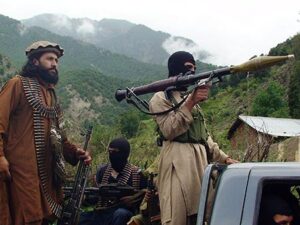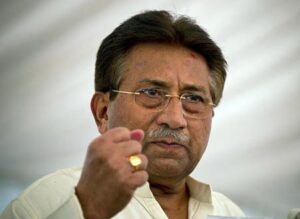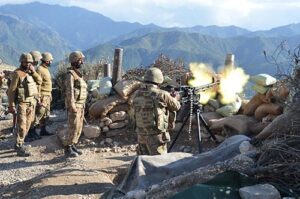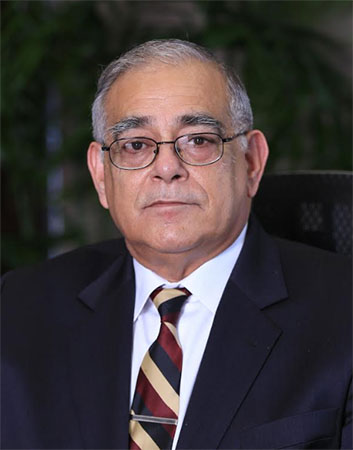‘To accept the legitimacy of state is to embrace the necessity for war. Political theory would be fine in a perfect world, but in an uncertain one, it is a dangerous gamble.’
— L.K. Samuels
The air was filled with the acrid smell of explosive material, blood and battle; there was mayhem and chaos as people ran about trying to escape from the horror of battle. It was the summer of 2010 at the foothills of Damadola. The countryside that would ordinarily be blooming with daisies was instead strewn with the debris of war. The old man sat on his charpoy outside his smoking mud hut, indifferent to the chaos around him, as if he had resigned himself to the inconsistencies of destiny and fate. I walked up to him and looked into his deep blue watery eyes and asked him, ‘Is there no Pashtun blood in your veins that you so easily allowed these people to kidnap your children —young boys and girls?” He got up slowly and took a step towards me, holding on to my chin, he said, ‘But where were you before all this happened?’ Implicit in his question was the accusation, that we, the State had abandoned them. We the State had allowed the Uzbeks, the Tajiks, the Arabs, Africans, the Chechens and numerous other criminals from almost all over the world to come and settle down, here amongst the tribal belt and hijack the tribes. They decapitated the leaders, usurped the tribal way of life, commandeered spaces, collected revenue by force and governed the area through coercion, force and terror, while the State remained conspicuous by its absence. Some agencies flew the Taliban flag or the Afghan flag — notably Bajaur. The State was not visible anywhere. The tribal belt was effectively a no-go area but as we made our way through the Agencies, liberating them from the hold of militant gangs that labelled themselves Tehreek-e-Taliban Pakistan (TTP), we vowed that we would not allow this to happen again. We built sixty forts in the heartland of the FATA belt and organised the permanent presence of the Frontier Corps amongst the tribes. Aurakzai, which had never been accessed, now had a Head Quarter in Kalaya. The commanding officer of a Wing of the Swat Scouts, was killed as he led an assault for the recapture of Kalaya, having lost it the night before to a massive attack launched from across the border.

As this conflict is almost behind us, I see confusion and doubt in people’s minds as to what was the nature and character of this war. The first phrase, that is getting great mileage these days is that, ‘military means are not a solution,’ and the second, is that ‘this was never our war.’ In the first instance, based upon my understanding, nowhere, ever, has there been a recognised institution or an establishment that has propagated in any way, that the military instrument is a method to resolve a crisis. There is never a black and white scenario where State policy can be pursued either by war or by diplomacy; one at the exclusion of the other. War is defined as the continuation of policy by other means (Clausewitz). In Statecraft, a policy is framed and to execute it diplomacy and politics always have a lead role. If they fail, the State has the prerogative to apply the military instrument with the sole view of creating an appropriate environment to return to the diplomatic/political instrument. In the end, all conflicts will always be resolved by a political settlement — mutually agreed to or coerced by one of the sides from a position of strength. To expect a military solution to resolve any conflict is to lean on absolutism and expect a total annihilation of the opposition where there is no last man left standing. This is not only impractical but never advocated. Thus, I am surprised by how this equation has crept into our political argument and reasoning; when it was never even a question. Even the US in Afghanistan, having used the military instrument continued to search for a political settlement by structuring a constitution, holding elections and then propping up an artificial government. It failed for so many reasons and the US left rather than continue to use the military instrument which they could have if they had wanted to. Nevertheless, the military instrument is necessary at times and at places but only to provide policy a chance to implement itself through diplomacy and politics — when to apply it is a judgement call of the leadership at that time.
In the second case, doing the rounds of ‘this was not our war,’ it would be pertinent to examine the United Nations Security Council Resolution 1373, unanimously adopted on 28 September 2001. People who are not aware, should note that any unanimous resolution passed by the United Nations, automatically becomes part of the National Laws of respective countries. However, in this case, it was specifically mentioned in one of its articles that National Laws were to be adjusted to accommodate the directions and instructions of Security Council Resolution 1373. Some of the most telling Articles in the resolution were, first, that all nations were to ensure terrorists were hindered and at that time the Taliban were declared terrorists; second, was to amend immigration laws and the third was to redefine refugee status; these were some amongst many others. One does not have to agree with the resolution but the choice then was to fight on behalf of the Taliban against a Coalition of 68 countries. Furthermore, India would be given an opportunity to cut Pakistan to size with global support by air and sea. Pakistan’s choices were to be either recognised as part of the solution or to fight the world as part of the problem. President Pervez Musharraf, having safeguarded Pakistan’s interest by aligning it with the globe rather than against it, went further, to protect its interests. First, he ensured that no troops served under ISAF or US command and any troops deployed remained under Pakistani leadership only. We were the only country in the Coalition that had that privilege. Second, he also made sure that no Pakistani troops were ever deployed outside Pakistani territory; neither in Afghanistan nor in Iraq, contrary to the other 68 nations contributing to the Coalition. The Pakistan Army only operated in its own territory.

Then there is the question of providing bases. Jacacobad was an F-16 Base and had US maintenance personal on it even before 9/11. Its status was changed to become a recovery base for the USAF. The other base, Shamsi, was technically given on lease to the UAE, that further allowed the US to operate drones and surveillance aircraft from it. Pakistan, of course, looked the other way but knew what was happening. Other than this, Pakistan provided its landlines of communication to access Afghanistan, since the latter was landlocked. However, being part of the war effort, this was the least Pakistan could have done to remain on the right side. Yet, in hindsight Pakistan could have done much better in regulating and controlling the passage of vital logistic supplies and here it had erred badly. None of these activities caused any kind of backlash or an uptick in militancy, which was already established in the FATA regions and was already in the process of commandeering spaces even before 9/11.
Most people think terrorism, violence, extremism and militancy began in Pakistan after 9/11. This is naivety and indifference to historical facts. Pakistan was born out of violence, right from its inception, where thousands were killed on the eve of 1947 during the Partition. Prime Minister Liaquat Ali Khan was assassinated by an Afghan in 1951, the Bengal Civil War saw thousands killed from 1952 up to 1971, the Balochistan insurgency from the 1960s is still ongoing, there was ethnic violence in Sindh, starting with the Karachi riots of 1985-86. Then there was the Pathan-Mohajir conflict in 1988, known as the Qasba-Aligarh massacre and the Pucca Qilla massacre in 1998, MQM versus the State in 1991, numerous target killings, kidnappings for ransom and forced bhatta collection. There was the religious violence starting with the anti-Ahmadi movement in 1950, ‘56 and ’70, the Rabwa incident in 1974. Justice Munir’s report must be read in this particular case. There were numerous attacks on Christian and Hindu minorities throughout Pakistan’s existence, sectarian violence in 1985-89; killing 300 Shias and another 1468 killed from 1989 to 2003. Militant organisations were formed to perpetuate violence: Sipah-e-Muhammed, Tehriq-e-Nifaz-e-Fiqh-e-Jaffaria, Tehreek-e-Jaffaria, Sipah-e-Sahaba, Lashkar-e-Jhangvi, Lashkar-e-Taiba amongst many more. These went on a killing spree against one another, unabated, unchecked and never prosecuted. It led to the Gilgit massacres of 1998, where 800 people were killed in a day. When you look at the history of Pakistani society, radical, extreme and violent, ready to take up sectarian, religious, ethnic or separatist causes, then the figure of 80,000 casualties over the last 20 years pales before the self-inflicted savagery perpetrated on our people by ourselves. To now sanctimoniously lament that we lost billions and so many lives implies we were a peaceful State where stability and constancy was our identity. It never was. Governments now are trying to hide the true nature of their lack of political will, poor governance and weak attitude towards violent extremism by blaming Pakistan’s current situation on the War on Terror which is a gross untruth.

After 9/11, the conflict focused in and around the FATA regions, which added to the already violent disposition within the country. However, militancy, as we see it in the FATA areas was a product of the organised resistance to Soviet occupation of Afghanistan. It involved $3 billion each from Saudi Arabia and the USA to fund a resistance movement. It attracted jihadists from the world over who were fascinated with the narrative that Pakistan spun and the US as well as the Saudis encouraged, the narrative of the Holy War. On the withdrawal of the Soviet occupation forces, Iraq invaded Kuwait (1990). The aftermath of the Afghan war against foreign occupation was forgotten and Pakistan was abandoned to handle the thousands of extremist militants, who returned to FATA and settled in along with 4 million refugees, all by itself. The militants assumed that having won the war, they were not to be subjected to any laws, national, local or even customary. Having wedded into the tribes, they claimed relationships and invoked the tribal custom of ‘protection to guests’ and merrily lived their lives undisturbed and without interference.
In this unholy mess, militants from all over saw a lucrative opportunity. Groups like Hizb-e Tahrir, (1953) Sipah-e-Sahaba (1985), Lashkar-e-Taiba (1987), Lashkar-e Jhangvi (1996), Jaish-e-Muhammed, (alleged to be part of Operation Topac since 1980) etc. jumped onto the bandwagon under different labels and found friendly havens in the relatively safe regions of FATA. They had built up an association with the Afghan Mujahidin and their foreign elements over the years. FATA now became a staging area against targets inside mainland Pakistan years before 9/11. This unholy alliance between the local tribes (more or less coerced), international jihadist groups and erstwhile militant groups from Punjab set up an organised violent campaign securing vast swathes of tribal territory. Subsequently, Al Qaeda (AQ), saw an opportunity and took over these militant groups, exploiting the situation to their own advantage.
Unlike the Afghan Taliban, whose agenda did not stretch beyond Afghanistan, Al Qaeda had global ambitions. Al Qaeda was a product of the Maktab al Khidmat, a bureau that Abdullah Yusuf Azam set up in the early 1980s as a coordination centre to recruit and induct Arabs to fight against the Soviets in Afghanistan. After Azam was killed somewhere in 1989, he was succeeded by Osama Bin Laden who gradually ensured the evolution of this organisation into Al Qaeda. The AQ leaders, such as Sheikh Essa, decided to establish the erstwhile FATA as their strategic backyard. AQ moved in a planned manner making the political agents of these tribal agencies irrelevant and totally dependent on the local militias. Men like Nek Muhammad and Baitullah Mehsud were given money and weapons. Within a few years, Al Qaeda established its stronghold. Tahir Yaldochev, the co-founder of the Islamic Movement of Uzbekistan (IMU) was a major AQ player. Sheikh Essa Al Misri, instructed him to convince Baitullah Mehsud that the real fight was against the Pakistan Army, while those fighting in Afghanistan were deviants. However, Mullah Umar sent a message through his emissary, Maulana Dadullah, to all the militant groups in Pakistan that they must stop all attacks against the State of Pakistan. His actual words were: “Immediately stop attacks on Pakistani security forces. This will lead to chaos and cannot be termed as Islamic Jihad. Jihad is being waged in Afghanistan so leave your place and come to Afghanistan to join the jihad against the Americans and their infidel allies.”
The message was ignored by all militant groups. Almost 50,000 fighters including Chechens, Uzbeks, and Arabs had gathered in the two Waziristans. A fatwa was broadcast by Tahir Yaldochev which made fighting the Pakistan Army a holy obligation that took on a higher obligation than fighting against the unholy West.
This led to the formulation of the Tehrik-e-Taliban Pakistan with Baitullah Mehsud, as the chief, operating from Ladha and surrounding areas, assisted by Maulvi Faqir of Bajaur and Hafiz Gula Bahader of Miran Shah in 2007. War was declared on Pakistan in January 2008 by the Mehsud Tribe under Baitullah Mehsud. Subsequently, Pakistan defeated Tehreek-e-Taliban Pakistan and its factions after clearing 46,000 sq km of Combat Zone, securing 3500 Kms of Lines of Communication and establishing the writ of the Government. The defeated TTP, amounting to about 6500 fled to the Kunar Valley of Afghanistan and were reorganised under the auspices of RAW, CIA and the NDS and merged with Jamaat ul Ahrar (JuA) and Hizb ul Ahrar (HuA). A pledge of allegiance was undertaken by the head of the TTP, Mufti Abu Mansour Asim, alias Noor Wali Mehsud. They also established ties with the Islamic State, known as IS Khorasan Province (ISKP), that is at war with the Afghan Taliban. The first group of militants for ISKP was formed by TTP leader, Hafiz Saeed Khan on July 14, 2012. Some other armed groups also joined the newly structured ISKP.
The Government of Pakistan was reluctant to deal with these groups prior to 9/11 because they lacked the political will and were worried about a backlash. This was always the case and in this State’s indifference to violent extremism, it was always the people who suffered. Finally, on account of signing up as part of the War on Terror, the government was forced to act. International pressure ensured that the State would finally do the right thing. Some capacity building was also built up and the State finally decided to deal with the scourge of militancy. Yet, the process began with the government offering the foreign elements to either lay down arms and register themselves or return to their respective countries. They refused and instead insisted that they had a right to wage Jihad and that they would do it from Pakistani territory. Yet the government went into a series of negotiations — each one of them failed in time though huge concessions were offered to the militants. The government even handed over Swat Valley and its unsuspecting people to Sufi Muhammed with the false sense of giving peace a chance. It failed and the militants sensing victory, wanted to take over even more area — militants were sighted in the Margalla hills — Islamabad was threatened. Finally, the State was obligated to take the fight to the militants and kinetic operations started in 2008, but that too only after Baitullah Mehsud declared war on the State in January 2008.
The operations led to clearing the entire area and establishing the writ of the government. This was all Pakistani territory, occupied by foreign resistance fighters supported by local criminal elements, who had labelled themselves as the TTP. The people of FATA were hostage to this aberration, abandoned while the government had acted apathetically and indifferently all this time. The alternative was to abdicate any authority over this space and forfeit the territory as integral to the Pakistani State. How can one now say that this was not our war and that too, say it with a straight face?
Now having got to where we are, the usual games have begun. There are attempts at creating splinter groups and causing a break up amongst the TTP by negotiating with elements inclined to deal. This has never worked. It’s just like creating the MQM to contain the Jamaat-e-Islami and then when MQM became larger than life, creating the MQM-H. We keep doing these things. Not negotiating with the TTP is not what is recommended, but that it should be done through a sensible plan. First, all of TTP as a whole should negotiate and not elements. If elements are accommodated, they are usually given concessions and one will soon find them driving down the border towns in black Vigos with armed masked men. They become the local touts and aman committees and once again, our local population is handed over to these criminals. The second point: any negotiations must be preceded by the TTP leadership holding the Pakistan flag, announcing their allegiance to the State and the Constitution. Thirdly, the tribal agencies where the maximum damage was done and other stakeholders (such as the parents of the APS School victims) must be given the lead role in establishing a Jirga (Reconciliatory Council). The government must only be seen as a coordination body facilitating reconciliation and not as the judge, eager to forgive and forget.
The State has fought this war to liberate its areas from the scourge of militancy. Many lives have been sacrificed and a lot of treasure exhausted. It is time to now consolidate the concept of how this State ought to function in the future. Will madrassas, Maulvis and extremists be allowed to continue to destabilise this nation as they have been doing since 1947? Here now is the opportunity when the State must lay down the law, governance has to be firm and not tentative. This country has no place for the likes of Mullah Aziz Burqa or heroes such as Mumtaz Qadri who murdered the very person he was supposed to protect. This country can no longer afford mobs such as the TLP or leaders who sell God and exploit religion for their own selfish pelf and privilege. We have had enough.

The writer is a retired Lt. General of the Pakistan Army. He is noted for his services as the Commander of I Strike Corps at Mangla & Inspector General of the Frontier Corps.



